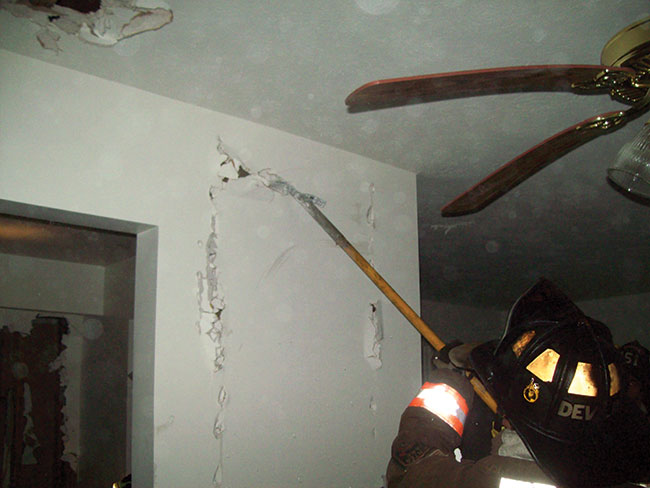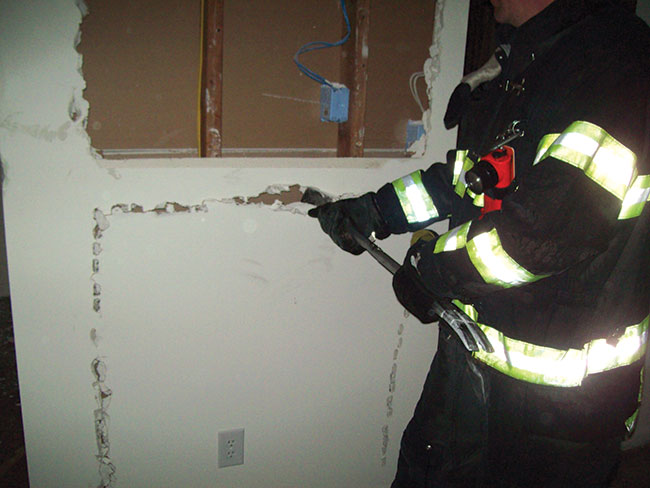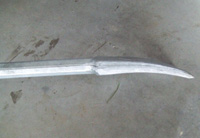
Features
Structural
Training
Back to Basics: March 2010
In the fire service we have many tools that we carry on our apparatus or in our pockets. Our fascination with tools is a longstanding tradition – just take a look at the vendors at trade shows and you will see hundreds of tools on display.
March 15, 2010
By Mark van der Feyst
In the fire service we have many tools that we carry on our apparatus or in our pockets. Our fascination with tools is a longstanding tradition – just take a look at the vendors at trade shows and you will see hundreds of tools on display. We have tools designed for every imaginable situation; if there isn’t a tool for a certain situation just wait and there will be. Tools give us the ability to complete the tasks that have been assigned to us; they are an extension of our hands.

|
||
| Photo 1: The Halligan bar and the roof hook – two favourite tools of the truck company firefighter |
||
 |
||
| Photo 2: The Hooligan bar has pins at the top and bottom end holding the fork and adz end to the shaft. | ||
 |
||
| Photo 3: The fork end of the Hooligan bar. Notice the thickness of the fork at the shaft end |
||
 |
||
| The fork end of the ProBar. The original design calls for a slimmer fork, allowing it to be versatile. Photos by Mark van der Feyst |
In basic training we teach firefighters to bring a hand tool of some sort. This is for two reasons; one is for personal survival and the other is for operational purposes. The matter of which tool to choose is sometimes a challenge but it’s important to choose the proper tool to do the job. Most of us bring just one hand tool because this is the way we have drilled, but we all have two hands and therefore can carry two tools. So why not carry two tools? If you are a truck company firefighter, you will know the value in having two tools with you when trying to complete a task. If there are two of you assigned to a task that means there are four hand tools at your disposal. Remember this saying, “two hands, two tools.”
At any truck company operation, we have a selection of tools at our disposal. In Back to Basics in August, I listed the 10 functions for which a truck company is responsible. Here they are again:
- Rescue
- Ventilation
- Forcible entry
- Reconnaissance
- Laddering
- Overhaul
- Elevated master streams
- Salvage
- Utility control
- RIT
Knowing these 10 functions dictates our tool requirements. The tools from which we select for truck company operations can be used for the majority of these 10 functions. (The only function that does not require hand tools is elevated master streams.) The basic tools for truck company operations are Halligan bar, roof hook, pike pole, axe (both flat head and pick head), chainsaws and rotary saws. All of these tools can be used to accomplish the nine truck company functions.
Photo 1 shows the roof hook and the Halligan bar. The Halligan bar is the most well known tool in the fire service. Invented by Hugh A. Halligan, a New York City firefighter, the Halligan bar is used primarily for forcible entry operations. It is the one tool from which we can benefit the most. Law enforcement agencies also benefit from this tool when they are forcing open doors to serve warrants. There are many Halligan bars on the market: the Halligan bar, the Hooligan bar and the Pro-Bar.
The Hooligan bar is an imitation bar (see photo 2). It has two pins holding the fork end and the adz end to the shaft.
The Halligan bar has two welds holding the fork end and the adz end to the shaft. Hugh Halligan’s original design used one piece of forged steel. This is referred to as the Pro-Bar on the market. It is balanced when carried and offers the most advantages when being used for forcible entry operations. The forks are bevelled such that they are on a slight angle to allow the best fit between the door frame and the door. They are also slimmer in design. Other imitation bars have their forks at extreme angles and are thicker than the original design (see photo 3). This offers very little advantage when using them for forcible entry. The thicker the fork, the harder it is to force open a door. The thinner the fork, the easier it will be to force the fork between the door frame and the door.
The Halligan bar can also be used for search operations as an extension of our arms; it can be used in ventilation operations for clearing out windows and it can be used for self extrication as an anchor point for firefighter survival.
The roof hook is another favourite tool of the truck company firefighter. Rising again out of the New York City Fire Department, this tool is designed for roof operations when trying to accomplish ventilation. These tools come in varying lengths with the most common being five- and six-foot lengths. As you can see in photo 1, the top of the tool has two angled hooks that are spaced apart from each other. The top hook has a sharp edge to it, allowing the user to penetrate through different surfaces both outside and inside the structure. Once penetrated through, the hook can then be used to pull down or pry the material off of the surface. It also serves well for sounding the roof when stepping onto it, and for advancing on the roof.
The bottom of a roof hook can have different ends. Some have a pry wedge, a fork, a D-handle, a ram knob or a gas shut-off tool. The most popular choice is the pry wedge. This allows the user to pry open various items, such as scuttle hatches, when trying to gain entry or ventilate.
The roof hook is also useful when conducting overhaul operations. The hooks allow the firefighter to pull off wall mouldings, trim, lath and plaster, tin ceilings, drywall, and door/window casings. By penetrating the wall surface or ceiling area, the hook can be used to create an inspection hole.
The roof hook is lightweight and is made out of one piece of metal. The original roof hooks are constructed from aircraft steel. Other versions are made from fibreglass and are not as strong as the aircraft steel models. The diameter of the hook is user-friendly, unlike pike poles, which can be cumbersome when wearing structural fire gloves. Many fire departments mount these two tools in different places on the apparatus. In photo 1, truck 516 has both tools mounted on the front bumper. These tools can also be mounted on the side of the apparatus near the rear passenger door, up by the platform on an aerial device, or with the ground ladders.
One firefighter with these two tools can accomplish a multitude of tasks on the fire ground. Having two tools in two hands, a firefighter – whether truck company or not – can be a valuable asset to the incident commander.
Mark van der Feyst is a 10-year veteran of the fire service and works for the City of Woodstock Fire Department in Ontario. He is an instructor for the PennsylvaniaState Fire Academy and the Justice Institute of BC and an associate professor of Fire Science for Lambton College. Contact him at Mark@FireStarTraining.com
Print this page